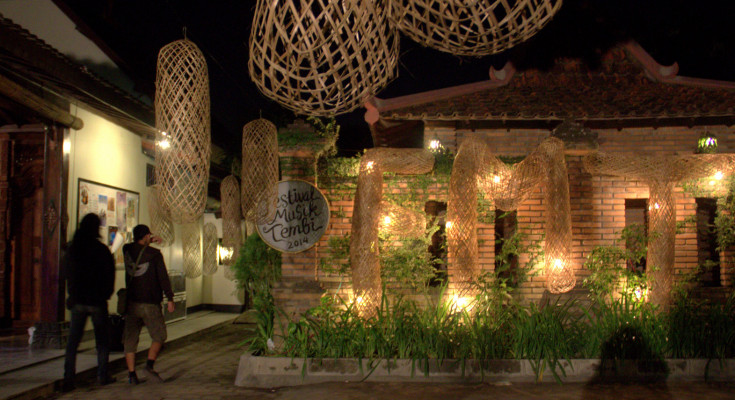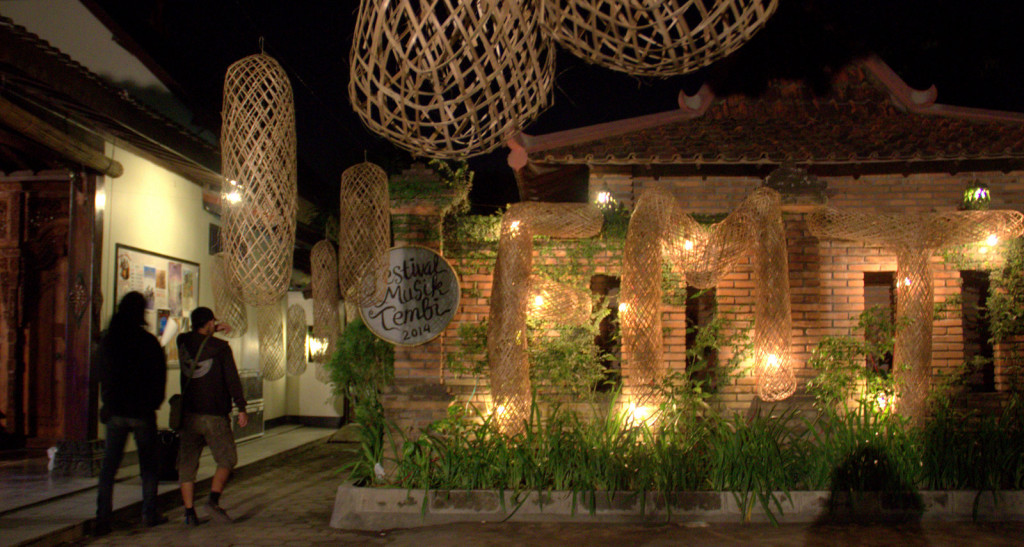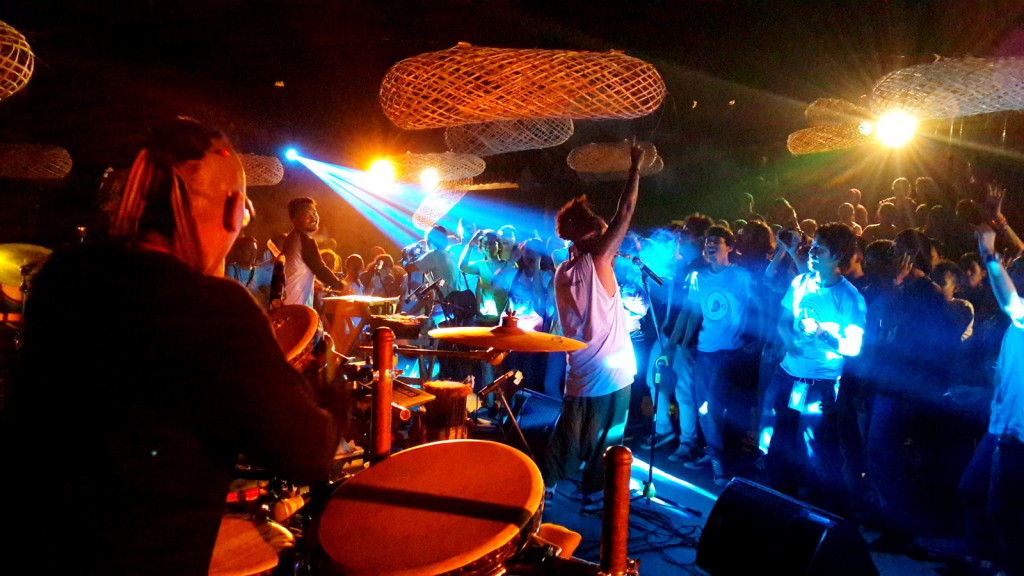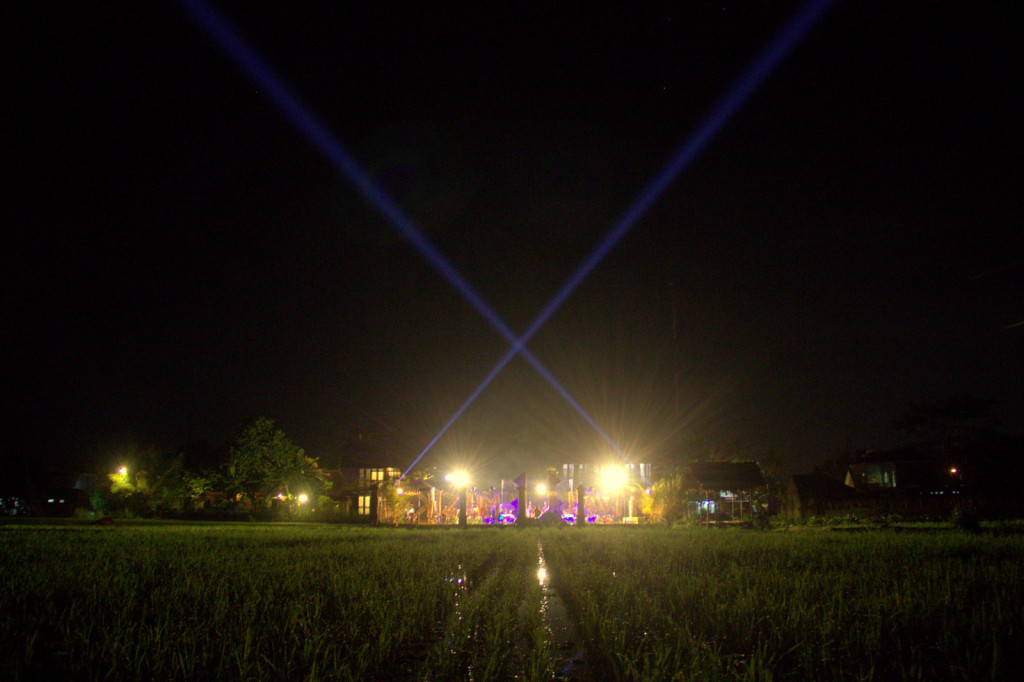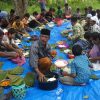By: Putri Fitria
Throughout history, art and knowledge have been the two main driving forces of civilization. Even today we still refer to the Renaissance geniuses, well versed in both science and art. I therefore agreed when the two hosts opening the Tembi Music Festival (FMT) 2014 said, “Just because we don’t talk politics here doesn’t mean we’re not smart. In fact, on the contrary, smart people talk about music.”
The FMT has been held annually by Forum Musik Tembi (foMbi) since May 2011, at Tembi Rumah Budaya, Yogyakarta. I was lucky to be one of the hundreds of attendees present when the gong was hit at the main hall of the Rumah Budaya, meaning House of Culture, FMT 2014 was on 22 May. The first night’s four performers, Bad Cellists, Swarasha, Saron Groove, and Risky Summerbee & the Honeythief, were able to excite the audience’s enthusiasm right from the beginning of the event. Richly decorated with Javanese ornaments, the venue was made even more lovely by the Krenengs (traditional sacks made of woven bamboo filaments) created by the Frog House creative community. The ambiance meant even those without a seat did not mind staying, hanging out with friends while listening to the music which was audible from all over the place.The FMT follows a regular program which includes the New Tradition Music (MTB) stage. This stage is part of FMT’s vision to provide a creative space for musicians to produce new music incorporating characteristics of traditional Indonesian music. “Our mission is to bring traditions into contemporary contexts, so traditional music can keep up with culture that is always moving,” explained Nuranto, founder of the Tembi House of Culture.
Discuss
Nuranto went on to say that Indonesian traditional music includes more than just Javanese music, and that what they have been trying to do since the first FMT is mix all music from across the Indonesian archipelago. They have also tried to create a new kind of music by adding cross-genre musical elements from around the world.
What Nuranto said was clearly illustrated in all the events of the FMT 2014. On the second day, the festival began at noon with music workshops by Kanako Abe, a Japanese conductor who has lived and worked in France for over ten years, and Kunokini, an ethnic percussion group that produce their music using various traditional Indonesian instruments. During the night, the participants of New Tradition Music 2014 were on stage. Of the nine performing groups, only seven were selected to be included in the compilation album of MTB 2014. These seven groups were Laring Project, Ocean Bridge, Daemiina, Sri Zamna, Kancaku, Vran, and Nyanyian Senja. They were chosen by three musical experts: ethnomusicologist Rizaldi Siagian, musician and music observer Joko S Gombloh, and music observer Ajie Wartono. The audience were also given a chance to discuss in the Bincang-Bincang Musik (Music Talks) session the following day.
The last night is always the most awaited in a festival. I am not exaggerating when I say that FMT 2014 reached its peak of merriment on Saturday night. Nearly all spaces in the House of Culture were crowded with people, who were either enjoying the show or visiting the community tables at the FMT 2014 Music Bazaar. Here, visitors could buy CDs, new or secondhand musical instruments, T-shirts and merchandise, as well as other creative art works.
Museum
The first performer, Kinanthi Sekar, played in the main hall. With a contemporary dance called Tarian Sri, meaning Sri’s Dance, Sekar conveyed a message to the audience. Wearing a red kebaya dress and a batik skirt, Sekar entered the hall with a lantern in her hand and carrying a bundle of rice plants on her back. Her dance was accompanied by a narrative of the dirty politics in Indonesia. “It is time they read, instead of leaving ‘dirty dishes’ and making the country miserable,” read one of the sentences that gave me the creeps.Etawa Jazz also performed. The group consisted of the piano, contrabass, and drums, and entertained the audience with their tunes. After Etawa Jazz’s performance, the audience were directed from the hall into the Museum of Tembi Rumah Budaya. There the folk duo from Yogyakarta, Wangi Hujan, were ready to carry the event on. Unfortunately for me, when I got to the door the museum’s room was already full of people.
Many people could not see the performance directly, but they could still enjoy the moody sounds of Wangi Hujan while walking around the Music Bazaar. As Wangi Hujan closed their show, the audience were again directed to the open-area amphitheater. An arrangement of gamelan instruments and some certain instruments from Banyuwangi were set up on stage. People were curious about what kind of music would be presented there. Soon a woman began to sing in Javanese, accompanied by violin.
Lare Osing
People were still carried away by the singer’s voice when various dances were performed by Sanggar Lang-Lang Buana. Eight child dancers in red Banyuwangi-style costumes came on stage in a very cute fashion. The movements of their tiny yet flexible and agile bodies amazed everyone. The performers moved through different dances: Jejer Gandrung portrayed a fertility goddess coming down from the heavens, Jaran Buto was about a brave soldier, Kembang Goyang illustrated the story of a beautiful village girl that had to put up with seduction, and Jaran Goyang depicted a woman who was attracted by a man because of some magic called ‘Lare Osing’.
The night was getting livelier when the last performer, Kunokini, got on the stage. People had jostled to sit on the floor shortly before, only to stand up again and move their body to the music being played. It was impossible not to; Kunokini were not just another traditional percussion group. They were able to create music with unique, irresistible beats. It was amazing that such local sounds of shehnai, tambourine, taganing, Sundanese drum, bamboo marimba, and other traditional percussion instruments, combined with Reggae vocals by Bismo, could result in such sexy music. They were truly a brilliant group.

